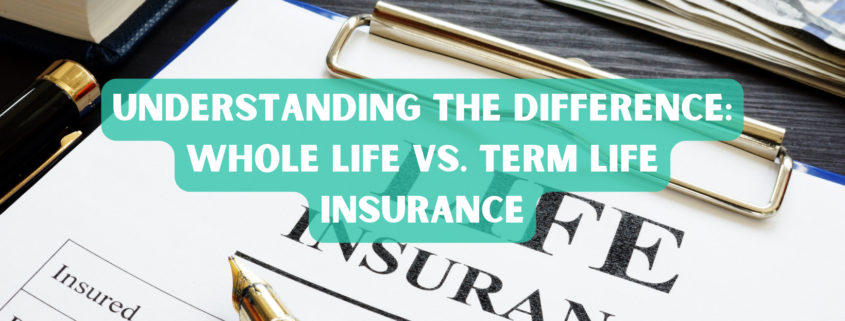Understanding the Difference: Whole Life vs. Term Life Insurance
Life insurance is a crucial component of financial planning, providing protection and peace of mind for you and your loved ones. When it comes to choosing a life insurance policy, two primary options emerge: whole life and term life insurance. Each type offers unique features and benefits, making it essential to understand the differences to make an informed decision. In this blog post, we’ll explore the distinctions between whole life and term life insurance to help you determine which option best suits your needs.
Whole Life Insurance: Building Wealth and Protection
Whole life insurance is a permanent life insurance policy that offers lifelong coverage, as long as premiums are paid. Here’s what you need to know about whole life insurance:
Features:
Lifetime Coverage: Whole life insurance provides coverage for the entirety of your life, offering peace of mind that your beneficiaries will receive a death benefit whenever you pass away.
Cash Value Component: One of the unique features of whole life insurance is its cash value component. A portion of your premiums goes into a cash value account, which grows over time on a tax-deferred basis. You can access this cash value through policy loans or withdrawals, providing a source of liquidity in times of need.
Guaranteed Premiums: With whole life insurance, premiums typically remain fixed for the duration of the policy, providing predictability and stability in your financial planning.
Benefits:
Wealth Accumulation: The cash value component of whole life insurance can serve as a tax-advantaged savings vehicle, allowing you to accumulate wealth over time while maintaining a death benefit for your beneficiaries.
Estate Planning: Whole life insurance can play a crucial role in estate planning, providing liquidity to cover estate taxes, debts, and other expenses without requiring your heirs to liquidate assets.
Final Expenses Coverage: Whole life insurance ensures that your loved ones have the financial resources to cover funeral expenses, outstanding debts, and other end-of-life costs without burdening them financially.
Term Life Insurance: Affordable Protection for a Specific Period
Term life insurance, on the other hand, is a temporary life insurance policy that provides coverage for a specific period, typically ranging from 10 to 30 years. Here’s what you need to know about term life insurance:
Features:
Fixed-Term Coverage: Term life insurance provides coverage for a predetermined period, offering protection during times of financial vulnerability, such as when raising a family or paying off a mortgage.
Affordable Premiums: Term life insurance premiums are generally lower than those of whole life insurance, making it an attractive option for individuals seeking affordable coverage.
No Cash Value: Unlike whole life insurance, term life insurance does not accumulate cash value over time. Once the policy term expires, coverage ends, and there is no return on premiums paid.
Benefits:
Cost-Effective Coverage: Term life insurance offers cost-effective coverage for individuals who need protection for a specific period, such as while raising children or paying off a mortgage.
Flexibility: Term life insurance provides flexibility to match coverage duration with specific financial obligations, allowing policyholders to tailor their coverage to their needs.
Supplemental Coverage: Term life insurance can complement existing financial plans, providing additional coverage during times of increased risk or financial vulnerability.
Choosing the Right Policy for You
When deciding between whole life and term life insurance, it’s essential to consider your individual financial goals, risk tolerance, and coverage needs. Here are some factors to consider:
Financial Goals: If your primary goal is wealth accumulation and long-term financial security, whole life insurance may be the right choice. However, if you’re primarily concerned with providing temporary protection for specific financial obligations, term life insurance may be more suitable.
Budget: Consider your budget and ability to pay premiums over the long term. Term life insurance typically offers lower premiums initially, making it more accessible for individuals with limited financial resources.
Coverage Needs: Evaluate your coverage needs based on your current financial obligations, such as mortgage payments, college tuition, and income replacement for your dependents. Choose a policy that aligns with your coverage needs and provides adequate protection for your loved ones.
Risk Tolerance: Consider your risk tolerance and investment preferences. Whole life insurance offers a guaranteed death benefit and cash value accumulation but may involve higher premiums and lower investment returns compared to alternative investment options.
In conclusion, both whole life and term life insurance policies offer valuable benefits and serve distinct purposes in financial planning. By understanding the differences between the two types of insurance and assessing your individual needs and preferences, you can make an informed decision that provides financial security and peace of mind for you and your loved ones.








Leave a Reply
Want to join the discussion?Feel free to contribute!